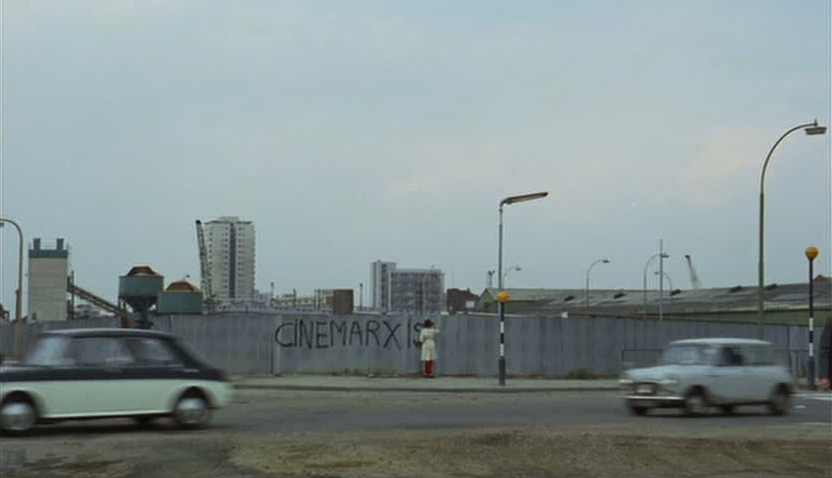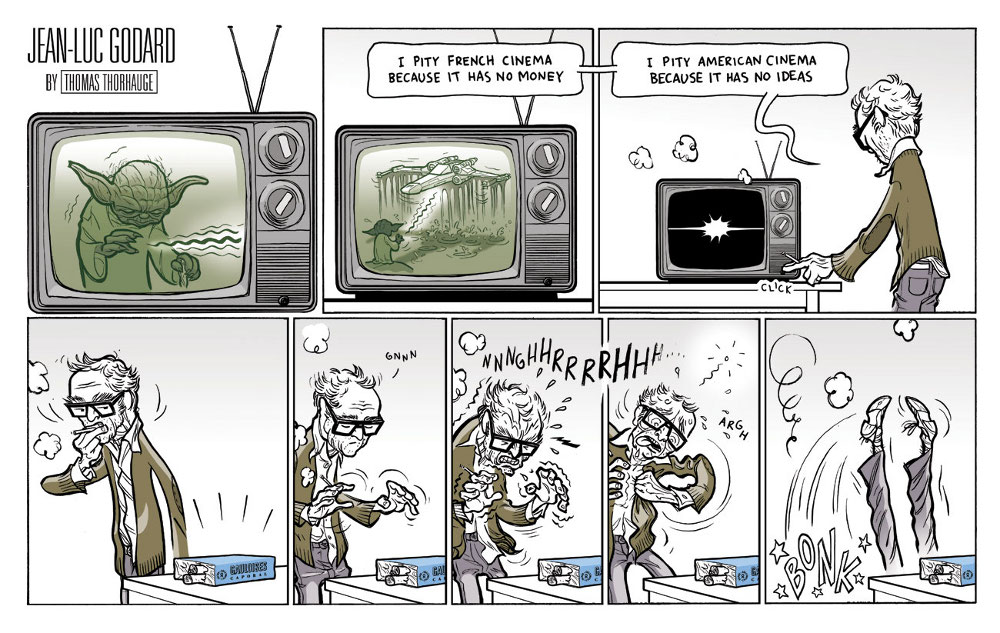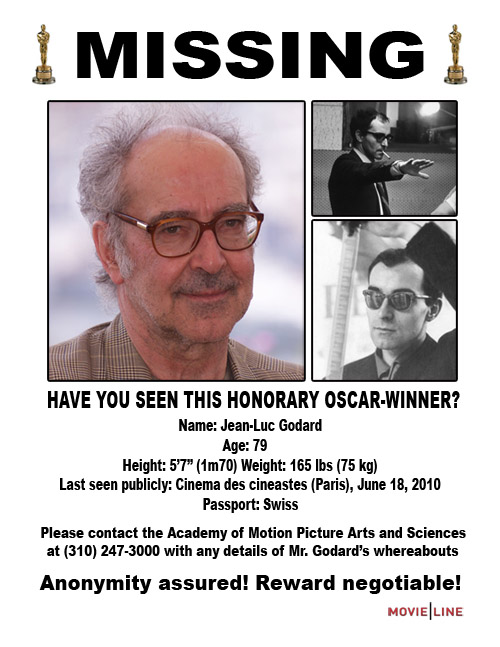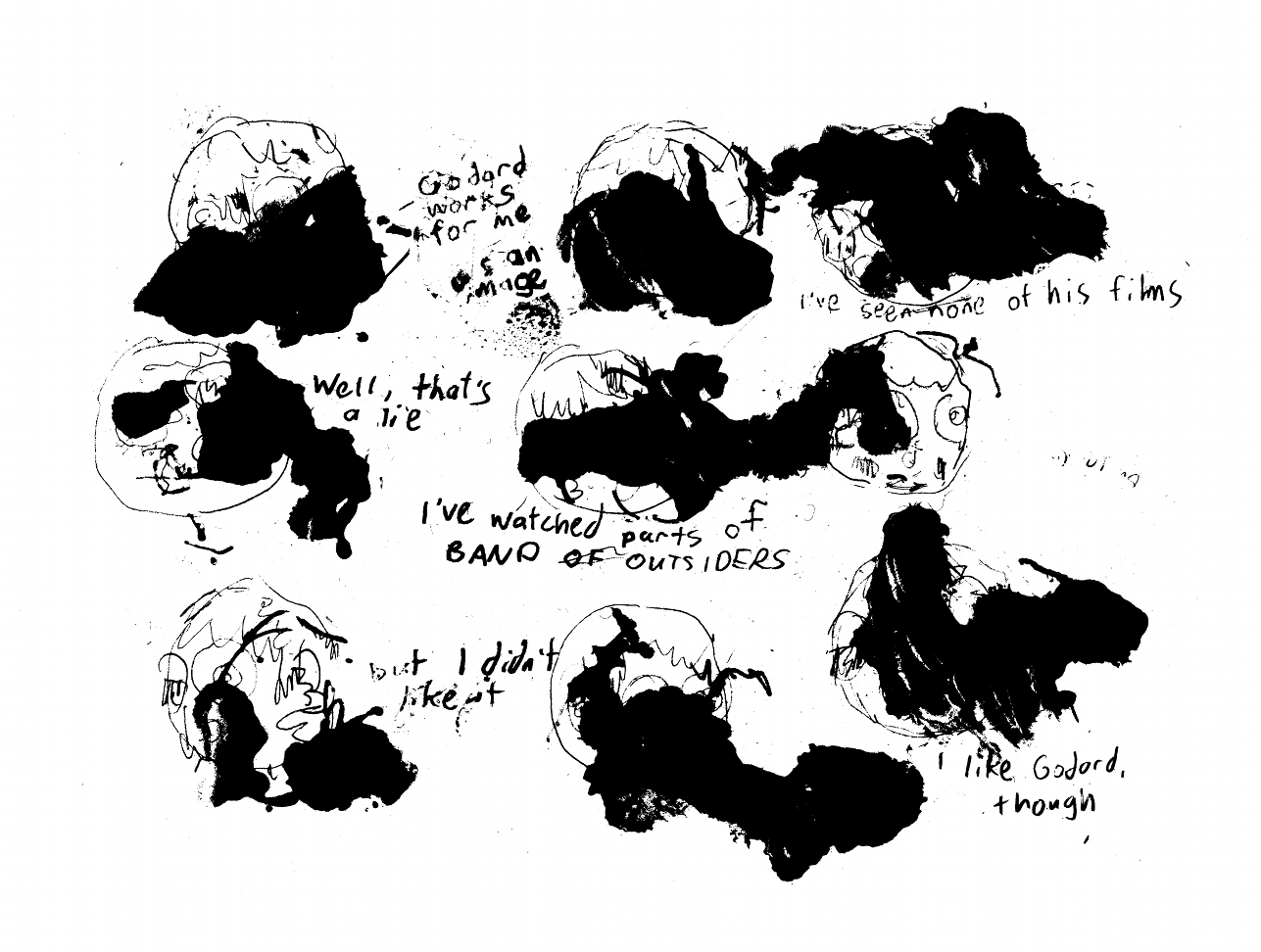To begin with, a generalization: Godardians really don’t like Quentin Tarantino. But, fear not, this post isn’t going to be about the latter, only the reasons expressed by the Godardians for their contempt. Wasn’t it Jean-Luc Godard himself who argued against a clear distinction between the fictional film and the documentary? For him, being even more opposed to naïve realism than Andre Bazin, the camera always had a perspective, a position, or as Colin MacCabe puts it: “there is not reality and then the camera – there is reality seized at this moment and this way by the camera.” [p. 79] It was this foundational belief that led to Godard’s dismissal of the anti-aesthetic implicit within cinema vérité, that reality comes from letting the film roll. Yet, Jonathan Rosenbaum (and I might as well mention Daniel Mendelsohn and HU’s very own Caroline Small) condemns Inglourious Basterds for “mak[ing] the Holocaust harder, not easier to grasp as a historical reality,” because “anything that makes Fascism unreal is wrong.” Evidently, fascism is just there waiting to have a camera pointed at it. No truth could possibly come out of a fantasy involving Nazism. In One Plus One, Godard films a neo-Nazi pornographic bookseller reading from Mein Kampf as his customers buy lurid novels and magazines — each person who makes a purchase gives a Nazi salute and slaps two captured hippies in the face. Is Godard making fascism easier to understand as a historical reality? More likely, the viewer is confused at this unrealistic scenario, but hopefully intrigued (or entertained) enough to contemplate what all these component images are doing there together in the middle of a rockumentary, e.g..: What does pornography have to do with fascism? What does any of this have to do with The Rolling Stones (the ostensible subject)? Just what the hell is Godard saying?
Rosenbaum refuses to regard Tarantino with any sort of reflection (I suspect too much identification, aka “entertainment,” and not enough distanciation aka “intellectual thought”). Inglourious Basterds is a film about other films, about movie conventions, and for that reason alone, “it loses its historical reality.” However, aren’t all of Godard’s quotations from films, news media, advertising and literature committed to the exact opposite point, that these images do have a historical reality in the way they construct/mediate who we are? If one is going to be derided for his narcissistic cinephilia (filtering everything through film), then the other should be, too. Rosenbaum mockingly quotes from an interview with Tarantino where he relates the 9/11 event to the spectacle of action films – not one of the director’s prouder moments, to be sure. Now consider Godard’s statement from La Chinoise’s press book:
Fifty years after the October Revolution, American cinema dominates world cinema. There’s not much to add to this state of affairs. Only that at our modest level, we must also create two or three Vietnams at the heart of the immense empire, Hollywood-Cinecittà-Mosfilms-Pinewood, etc. as much economic as aesthetic, that’s to say struggling on two fronts, to create national cinemas, free, brotherly, comrades and friends. [p. 182, MacCabe]
Although MacCabe gives this a sympathetic spin, noting how Godard has always been aware that his “oppression” isn’t as “grievous” as what was done to the Vietnamese, there’s not much he can do with the foolhardiness of the director’s feeling “solidarity” with them because “his own experience” is “the very same predicament.” I’m going to assume that the imperialism of having too many theaters showing American movies is quite obviously not the oppression of a napalm bath, as a spectacle or otherwise, and move on.
On the other hand, Godard’s kinocentrism (sounds better than ‘cinecentrism’) also served to make him film’s most indefatigable and important moral critic of the Sixties – at least, regarding his chosen medium (as we’ll see, I’m more skeptical of his role as a social critic). If his films of that period are about any one topic, it’s the relation of cinematic form to reality, how one shapes the other, and the filmmaker’s charge in relating his or her film to an audience. As our reality was becoming increasingly mediated by images, where the representation of life was replacing life and human relations were displaced through commodities (compare Pierrot le fou’s famous dinner party scene in which the guests communicate through ad-speak to Guy Debord’s Society of the Spectacle), Godard radicalized his films in Brechtian fashion by subverting cinema’s conventions, calling attention to their mediating effects (albeit Debord and the Situationists weren’t fans): music pops up arbitrarily, dialogue doesn’t sync with the images, quotes (both visual and textual) are used in abundance but frequently have no logical connection to what little plot is involved, etc. As the title sequence for 1965’s Pierrot le fou fades to just the O’s, Godard, relating to the world through cinema, but ever more distrustful of the reality of images, announced his intent, to return filmmaking to degree zero. His films would become more radical (and more impenetrable to the average filmgoer).
Ever since I first saw it, One Plus One has alternately bored, frustrated and fascinated me in roughly equal measure. Godard called it his last bourgeois film, since it was the last of the period (following Week End) to be financed through conventional means and wasn’t as collaboratively directed as his subsequent efforts with the Maoist Dziga Vertov Group (where the group received auteur credit and they would try to make films via committee). Indeed, other than featuring The Rolling Stones, the film is probably best known by the incident where the director punched his producer, Iain Quarrier (who plays the bookseller), in the nose for having altered the ending to include the completed version of “Sympathy for the Devil” and renaming the film with the song title – that is, Godard hadn’t abandoned all vestiges of his own auteurship. Nevertheless, it was the first of his films to follow the transformative events of the Langlois Affair and May 1968, a transition into what’s typically known as his radical period, where he and his collaborators (particularly Jean-Pierre Gorin) attempted to realize the revolutionary potential of film.
Through long tracking shots between the band members in a recording studio, each often surrounded by soundboards, the film conveys the amount of individual effort and labor time involved, 1 + 1, even in manufacturing something as seemingly disposable as a pop song. By refusing to give the audience the finished version (in the director’s cut), the focus is on the collaboration, rather than the commodity. Likewise, the mise-en-scène is an attempt to not single out any particular member as a star (although, unsurprisingly, Mick Jagger and Keith Richards speak more than the rest while the drug-addled Brian Jones nearly vanishes on camera). Against the visual images, a narrator reads from a smutty political novel (involving, among others, Pope Paul and LBJ in lascivious encounters), which intrudes upon the traditionally diegetic sound, dialectically challenging the notion of a unified film diegesis. And against The Stones in the studio, Godard counterposes other, tenuously related sequences: the media interrogation and eventual demise of Eve Democracy (Anne Wiazemsky, JLG’s second wife); in a junkyard, black militants read Black Power disquisitions, pass guns to each other (within long lateral tracking shots) as they molest and slaughter white women; and there’s the aforementioned bookstore where men and women, old and young, bourgeois and working classes can purchase smut and racist, violent pulp. To quote Mao Zedong (lifted from Slavoj Žižek): “In any given thing, the unity of opposites is conditional, temporary and transitory, and hence relative, whereas the struggle of opposites is absolute.” Godard is quite brilliant in formally instantiating Mao’s “the one divides into the two,” forcing the viewer to engage the filmic elements dialectically, but does the film effect any change outside of cinema, or even demand such a change?
I’m inclined towards Roger Greenspun’s early summation: “Whatever its intentions, One Plus One contemplates rather than advocates revolution.” It’s about the use of revolutionary ideas to make a film, rather than a film serving the revolution. Exploiting The Rolling Stones’ popularity could’ve been advantageous to spreading radical ideas to the masses, but not when it takes something like an intellectual interpretation of Mao to understand those ideas. The film could only fail in its didactic purpose, since it was ultimately aimed at other cinephiles already sympathizing with the ideology – i.e., white bourgeois radicals, the type of person who really gets the joke of juxtaposing a successful blues-based rock band against a black militant reading LeRoi Jones on the white appropriation of black music. But is Godard doing anything differently here? He uses the image of black militancy to lend authenticity to his kinocentric radicalism much like he analogized his own oppression to that of the Vietnamese, as if he’s there with them in the junkyard – the void of Western culture. At least The Stones have a genuine love for the American Blues. I’m not so sure that Godard expresses anything more than a narcissistic interest in the struggle of American blacks (namely, what it might mean to his ideas of a revolutionary cinema). Since I find this representative of a certain navel-gazing self-importance endemic to Godard’s films (what most of his detractors would call ‘boring’), I’m going to focus the rest of the essay on what’s problematic about his use of black representation.
First, consider this more favorable interpretation from Gary Elshaw (providing the most insightful and comprehensive critique of the film that I’ve found):
Godard’s desire to “destroy culture” is illustrated by [Eldridge] Cleaver’s own desire to destroy the dominant culture, a culture that is led in the form of the ‘Omnipotent Administrator’. The ‘Omnipotent Administrator’ represents white male patriarchal power, a power which often manifested itself as governmental and repressive.
Contrariwise, I find a bit of minstrelsy in Godard’s use of black men in that it’s a savage image, regardless of their literary references. Now, I understand that their violence stems from what he surely agrees is white oppression, but their abstracted appearance here is more a metaphor for his own struggle to destroy the Hollywood Empire’s hegemony than to capture the reality of blackness. Black Power is to Godard’s target audience what Leadbelly was to the “open-minded,” left-leaning white audiences of his time. As Hugh Barker and Yuval Taylor put it (in their book Faking It: The Quest for Authenticity in Popular Music): “[B]y the twentieth century, with the influence of Darwin and Freud, it was primarily the Negro who had become idealized, and this time as the primitive – pure id, and therefore profound.” [p. 10] Despite the soft-spoken musician’s preference for suits, his promoter and producer, John Lomax, insisted on the commodified image of the prison-garbed, convicted murderer, selling an idea of authentic repression by reflecting (however well-meaning) white bias. Isn’t this what Godard’s doing with the black militants, by presenting the violent return of the repressed black to white radicals calling – at least, intellectually – for a violent revolution? Solidarity, go primitive, back to zero. Eve Democracy dies while fighting beside blacks on a beach at the end. As the most likely stand-in for the director (espousing many of his views during the interview earlier), that it’s her corpse raised on the Hollywood-sized camera crane (Godard’s “omnipotent administrator”) in the last shot is, I believe, telling.
My triangulation is similar to the scene in Week End where two previously warring parties, an anti-Semitic woman and a communist farmer, are united in their disdain at the self-centeredness of the lead bourgeois couple, Corinne and Roland. As Frank B. Wilderson III argues (in Red, White & Black):
[T]he imaginative labor of White radicalism and White political cinema is animated by the same ensemble of questions and the same structure of feeling that animates White supremacy. Which is to say that while the men and women in blue, with guns and jailers’ keys, appear to be White supremacy’s front line of violence against Blacks, they are merely its reserves, called on only when needed to augment White radicalism’s always already ongoing patrol of a zone more sacred than the streets: the zone of White ethical dilemmas, of civil society at every scale, from the White body, to the White household, through the public sphere on up to the nation. [p. 131; capitalized White and Black refer to structural positions]
By being a reflection of his kinocentrism – cinephilia his “zone of White ethical dilemmas” – Godard’s attempted solidarity with the American Black Power movement becomes aligned with early twentieth century white condescension. On the one hand, there’s the offense at Henri Langlois being unjustly removed from the Cinémathèque Française and, on the other, there’s former Slausons member Kumasi’s memory of the Watts Riots (from the film Crips & Bloods: Made in America):
You cannot woop us. We’re already dead. We’re already beaten down — we’ve been beaten down for 400 years. We already got the wounds inside and outside our bodies; how you gonna hurt us? […] Here’s a dilapidated building; ain’t nobody livin’ there. You didn’t fix it; you didn’t remove it, okay? It ain’t nothing but a pile of bricks, anyhow. That’s comin’ at you. That whole building, brick by brick, is comin’ at yo’ ass. That’s what we’re throwin’ at you: the building, the bullshit, the rubble, the rubbish that we live in. That’s what’s comin’ at yo’ ass. Those are our weapons: the filth, the funk, the shit that you can’t stand — that you defend, that you put a barrier between us and yo’self. That’s comin’ at you.
Wilderson would argue that these two forms of oppression aren’t just different in degree, but in ontological kind. Godard’s attempt to draw a structural parallel (say, between the censoring of films under the de Gaulle regime and the way the black population was cordoned off in Southern Los Angeles) is based on a false analogy. This “ruse,” as Wilderson calls it, hides the ontological violence perpetrated on blacks through slavery, whereby Blackness became defined as fungibility and accumulation – Inhuman, Dead. As for the communist struggle, quoting Wilderson again: “workers labor on the commodity, they are not the commodity itself, their labor power is.” [p. 50] Not that it would be much more plausible, but Godard should’ve kept his analogies of oppression to those of the striking workers in May 1968, since they were struggling with alienation and exploitation, not necessarily their position as Human. It was his solipsism that ensured One Plus One would be best remembered for its formal inventiveness or, most often (for example), as a collection of snazzy clips of The Stones at the beginning of their most inventive period.
REFERENCES (not all of them cited in the text):
Hugh Barker & Yuval Taylor, Faking It: The Quest for Authenticity in Popular Music
Gary Elshaw, “The Depiction of Late 1960s’ Counter Culture in Jean-Luc Godard’s One Plus One/Sympathy for the Devil”
Stephen Glynn, “Sympathy for the Devil”
Roger Greenspan, “Sympathy for the Devil (1+1)”
Colin MacCabe, Godard: A Portrait of the Artist at Seventy
David Sterritt, The Films of Jean-Luc Godard
Donato Totaro, “May 1968 and After: Cinema in France and Beyond”
Frank B. Wilderson, III, Red, White & Black: Cinema and the Structure of U.S. Antagonisms
Slavoj Žižek, “Mao Zedong: The Marxist Lord of Misrule”
______________
The Godard Roundtable index is here.








